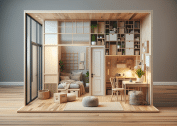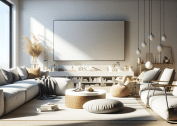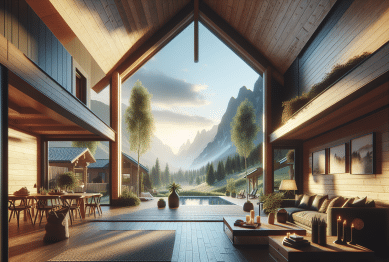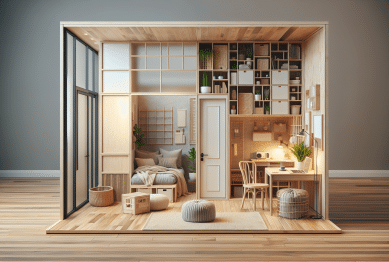Unlock ingenious ways to make the most out of any small apartment. Discover smart storage solutions, multifunctional décor, and lifestyle tweaks that turn compact spaces into vibrant, comfortable homes. Explore how simple design tricks and organization hacks can maximize comfort and invite relaxation.
Making Every Inch Count in Small Spaces
Living in a tiny apartment is both a creative challenge and a lifestyle trend gaining popularity in urban centers worldwide. The appeal often goes beyond just affordability; city dwellers crave efficiency and cozy retreats. The right interior design can convert even the smallest unit into a functional oasis. Integrating vertical storage solutions or floating shelves allows people to store books, décor, or electronics without sacrificing precious floor area. Small-space living changes perspectives about what truly matters in a home.
Multifunctional furniture is a cornerstone of modern apartment design, especially in tight quarters. A fold-down table can provide a work-from-home zone during the day and seamlessly tuck away after dinner. Sofas that convert to beds invite overnight guests without crowding daily routines. With thoughtful planning, each piece becomes part of a lifestyle strategy rather than just a furnishing choice. Adapting to a smaller footprint often leads to a more conscious and clutter-free lifestyle.
Tiny apartments foster a new type of creativity among residents. Decorating with mirrors increases natural light and creates an illusion of added space. Selecting compact, stackable chairs can instantly free up room for yoga sessions or social gatherings. Maximizing every corner, including under the bed or over doorways, cultivates a resourceful approach to both possessions and leisure. Small-space living guides individuals to reassess personal needs and design surroundings that truly suit their lifestyles.
Smart Storage Solutions You May Overlook
Clever storage increases functionality in ways many overlook. Consider wall hooks in the hallway for jackets, which save closet space instantly. Shoe racks beneath entry benches double up as additional storage locations. Transparent bins stored on high shelves make seasonal gear easy to access and organize. By thinking vertically and reimagining unused spots, homeowners can eliminate clutter while enjoying easy access to essentials.
Kitchen storage often presents special challenges in apartments. Pull-out cabinets or organizers under sinks make for sensible use of awkward spots. Magnetic strips mounted on walls hold knives or utensils within easy reach. Collapsible kitchen tools minimize drawer congestion. A tidy and efficient cooking zone can inspire healthier eating habits and reduce daily stress. Every time a tool or ingredient has a dedicated spot, meal prep feels smoother and the entire home benefits.
Beds with built-in drawers provide hidden rooms for linens and rarely used items. Multipurpose coffee tables offer extra compartments for remote controls, magazines, or even extra pillows. Closets can be upgraded with double rods or customized shelving to optimize both hanging and folded storage. These details transform limited square footage into smart, ordered environments. Ultimately, well-planned storage supports both mental clarity and physical comfort in daily routines.
Décor Tricks for a Bigger, Brighter Feel
Color palettes play a powerful role in amplifying perceived space. Lighter wall colors, from soft whites to gentle pastels, reflect light and open up interiors. Pairing these tones with sheer curtains or strategically placed lamps increases brightness, making any room feel more welcoming. Consistency—choosing complementary shades for furniture, textiles, and art—helps rooms appear more relaxed and spacious.
Textures bring dimension and interest to tiny spaces without visual clutter. For example, adding a woven rug in the living area defines zones while introducing warmth. Plants on windowsills or wall planters add fresh energy and cleaner air. Layering throws and cushions helps interiors feel inviting but not overwhelming. The right balance between minimalism and cozy touches is key.
Mirrors are a time-tested tool for making rooms look larger. Placing a large mirror near a window doubles incoming sunlight and showcases outdoor views. Mirrored furniture or decorative trays add sparkle and make layouts more dynamic. Artfully arranging wall décor in clusters consolidates visual stimuli, reducing messiness. By using these techniques, anyone can create an environment that feels bigger and brighter—regardless of square footage.
Balancing Comfort and Functionality Daily
One of the greatest misconceptions about compact living is that comfort must be sacrificed. Instead, many find their homes feel more personal and restful. By choosing ergonomic seating or mattresses, comfort becomes integral, even in tight corners. Simple additions, such as plush rugs underfoot or blackout curtains in the bedroom, improve rest and relaxation for every resident.
Daily routines become smoother with purposeful organization. Keeping a landing spot by the door for keys, mail, or bags prevents mornings from becoming rushed. Using stackable baskets as laundry bins can save floor space and encourage tidiness. Implementing routines around cleaning and decluttering ensures the space remains both livable and pleasing when schedules get busy.
Comfort also includes emotional well-being. Small apartments often encourage close connections with neighbors or roommates. Setting aside a reading nook near the window or dedicating a corner to hobbies brings joy and a sense of belonging. When every element is chosen for a reason—whether practical or sentimental—tiny apartments transform into cherished retreats from the city outside.
Hosting and Entertaining in Tiny Homes
Hosting friends in a small apartment may feel daunting, but clever strategies make get-togethers smooth and fun. Movable furniture like nesting tables and folding chairs allow rapid reshaping of spaces for guests. A rolling bar cart can be stowed away after use, freeing up space and keeping beverages neatly organized. The key is selecting pieces that blend seamlessly with daily living but shine during special gatherings.
Creative serving solutions abound for compact homes. Instead of oversized platters, choose stackable serving dishes or finger foods arranged vertically. Lighting also matters—a string of warm lights or a few candles sets a cozy mood without crowding the room. Entertainment can focus on board games that require minimal space or themed playlists to boost ambiance. Flexibility and thoughtful design are what make memorable gatherings possible in tiny apartments.
After the party, streamlined cleaning routines become essential. Stowable cleaning tools in closets or under sinks simplify the process. Encouraging guests to use coasters or stack plates ensures surfaces stay tidy. Making hospitality part of small-space living builds community, proving that great company needs only creativity and heart, not extra square feet.
Upgrading Lifestyle with Technology and Trends
Technology shapes how compact homes feel and function. Smart lighting responds to voice commands and can create the illusion of daylight any hour. Multiroom audio enables music or podcasts anywhere, while robot vacuums keep hard floors spotless with minimal effort. With wireless charging pads and compact projectors, tech essentials are integrated without taking over valuable surfaces. The rise of the “tiny tech” movement brings sophistication and convenience to small-space living.
Sustainability is a popular trend in modern apartments. Energy-efficient appliances reduce costs and environmental impact. Water-saving shower heads and smart thermostats keep utilities manageable. Repurposed and upcycled furniture supports eco-friendly values and often brings a unique look to interiors. Living well in a small space means considering the impact of each item—on both the planet and personal finances.
Social media inspires continuous improvement. Influencers and design experts frequently share tips for tiny apartment living, from DIY décor projects to routines for maximizing storage. Connecting with online communities provides support, inspiration, and troubleshooting when challenges arise. The result? Homes that evolve alongside lifestyles, proving small spaces can deliver big comfort and creativity.
References
1. National Association of Home Builders. (n.d.). Optimizing Small Spaces. Retrieved from https://www.nahb.org/advocacy/industry-issues/optimizing-small-spaces
2. The Spruce. (n.d.). Small Apartment Organization Tips. Retrieved from https://www.thespruce.com/small-apartment-organizing-ideas-2648466
3. American Institute of Architects. (n.d.). Design Strategies for Small Homes. Retrieved from https://www.aia.org/articles/6313026-small-home-design-solutions
4. Energy Star. (n.d.). Home Appliance Energy Use. Retrieved from https://www.energystar.gov/products/appliances
5. Apartment Therapy. (n.d.). Small-Space Entertaining. Retrieved from https://www.apartmenttherapy.com/small-space-hosting-tips-367591
6. Environmental Protection Agency. (n.d.). Energy Efficiency at Home. Retrieved from https://www.epa.gov/energy/green-tips-energy-efficient-homes









